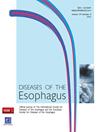左柱夹闭术微创修补疝旁疝
IF 2.3
3区 医学
Q3 GASTROENTEROLOGY & HEPATOLOGY
引用次数: 0
摘要
在微创食管切除术时代,导管旁疝的手术修复提出了越来越大的挑战。关键原则是保留胃导管及其右门大网膜血管拱廊,并持久关闭缺损。在各种方法中,后路的脚部修复是很困难的,不需要动员、冒险和扭曲导管,而前路修复一个大的缺陷需要补片,这有感染或侵蚀的风险。对于合适的手术技术尚无共识。我们建议将裂孔的左支柱夹紧以提供有效的修复。这是安全的,因为解剖和缝合远离导管和拱廊。我们发现左支柱足够灵活,可以进行修复,缝合线位于左半隔膜的肌腱部分,提供耐用性。我们提供了两个视频来描述该技术的关键步骤,并证明该技术对大小缺陷以及急性和慢性导管旁疝都是有效的。链接:https://1drv.ms/v/s ! Anu-cyBTuGbsgbxtX8aLf2P1YEPl9g ? e = fXz7Pm。请联系我,shantjog@gmail.com如果这个链接不起作用,我会探索另一种方法来分享视频。多谢。本文章由计算机程序翻译,如有差异,请以英文原文为准。
397. LEFT PILLAR PINCHING TECHNIQUE FOR MINIMALLY INVASIVE REPAIR OF PARA-CONDUIT HERNIA
Surgical repair of the para-conduit hernia provides an increasing challenge in the era of minimally invasive oesophagectomy. The key principles are preservation of the gastric conduit and its right gatro epiploic vascular arcade, and durable closure of the defect.
Of various methods, posterior crural repair is difficult without mobilising and risking and kinking the conduit, while anterior repair of a big defect requires the adjunct of a mesh which carries its own risks of infection or erosion. There is no consensus on the appropriate surgical technique.
We propose that the Left pillar of the hiatus be pinched to provide an effective repair. This is safe as dissection and suturing is well away from the conduit and arcade. We find the left pillar to be adequately mobile to allow repair, and the sutures sit in the tendinous portion of the left hemi diaphragm to provide durability.
We provide 2 videos to describe the key steps in this technique and demonstrate that this technique is effective in both small and large defects, and acute and chronic para-conduit hernia.
Link: https://1drv.ms/v/s!Anu-cyBTuGbsgbxtX8aLf2P1YEPl9g?e=fXz7Pm.
Please contact me, shantjog@gmail.com if this link does not work and I will explore an alternative method to share the video.
Many thanks.
求助全文
通过发布文献求助,成功后即可免费获取论文全文。
去求助
来源期刊

Diseases of the Esophagus
医学-胃肠肝病学
CiteScore
5.30
自引率
7.70%
发文量
568
审稿时长
6 months
期刊介绍:
Diseases of the Esophagus covers all aspects of the esophagus - etiology, investigation and diagnosis, and both medical and surgical treatment.
 求助内容:
求助内容: 应助结果提醒方式:
应助结果提醒方式:


